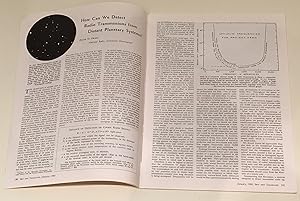detect radio transmissions distant planetary von drake frank (1 Ergebnisse)
FeedbackSuchfilter
Produktart
- Alle Product Types
- Bücher (1)
- Magazine & Zeitschriften (Keine weiteren Ergebnisse entsprechen dieser Verfeinerung)
- Comics (Keine weiteren Ergebnisse entsprechen dieser Verfeinerung)
- Noten (Keine weiteren Ergebnisse entsprechen dieser Verfeinerung)
- Kunst, Grafik & Poster (Keine weiteren Ergebnisse entsprechen dieser Verfeinerung)
- Fotografien (Keine weiteren Ergebnisse entsprechen dieser Verfeinerung)
- Karten (Keine weiteren Ergebnisse entsprechen dieser Verfeinerung)
- Manuskripte & Papierantiquitäten (Keine weiteren Ergebnisse entsprechen dieser Verfeinerung)
Zustand Mehr dazu
- Neu (Keine weiteren Ergebnisse entsprechen dieser Verfeinerung)
- Wie Neu, Sehr Gut oder Gut Bis Sehr Gut (1)
- Gut oder Befriedigend (Keine weiteren Ergebnisse entsprechen dieser Verfeinerung)
- Ausreichend oder Schlecht (Keine weiteren Ergebnisse entsprechen dieser Verfeinerung)
- Wie beschrieben (Keine weiteren Ergebnisse entsprechen dieser Verfeinerung)
Einband
- alle Einbände
- Hardcover (Keine weiteren Ergebnisse entsprechen dieser Verfeinerung)
- Softcover (1)
Weitere Eigenschaften
- Erstausgabe (1)
- Signiert (Keine weiteren Ergebnisse entsprechen dieser Verfeinerung)
- Schutzumschlag (Keine weiteren Ergebnisse entsprechen dieser Verfeinerung)
- Angebotsfoto (1)
- Keine Print-on-Demand Angebote (1)
Sprache (1)
Preis
- Beliebiger Preis
- Weniger als EUR 20 (Keine weiteren Ergebnisse entsprechen dieser Verfeinerung)
- EUR 20 bis EUR 40 (Keine weiteren Ergebnisse entsprechen dieser Verfeinerung)
- Mehr als EUR 40
Gratisversand
- Kostenloser Versand nach Deutschland (Keine weiteren Ergebnisse entsprechen dieser Verfeinerung)
Land des Verkäufers
Verkäuferbewertung
-
How can we detect radio transmissions from distant planetary systems?' pp. 140-143 in Sky and Telescope, Vol. XIX, No. 3, January 1960. Original printed wrappers. PROJECT OZMA: THE BIRTH OF SETI AND THE DRAKE EQUATION
Verlag: Harvard Observatory, Cambridge, MA: Sky Publishing Corporation, 1960
Anbieter: Landmarks of Science Books, Richmond, Vereinigtes Königreich
Erstausgabe
EUR 1.125,08
Währung umrechnenEUR 17,25 für den Versand von Vereinigtes Königreich nach DeutschlandAnzahl: 1 verfügbar
In den WarenkorbSoft cover. Zustand: Near Fine. 1st Edition. FIRST EDITION OF THE FIRST PROPOSAL TO SEARCH FOR EXTRA-TERRESTRIAL INTELLIGENCE. "In 1960, radioastronomer Frank D. Drake, then at the National Radio Astronomy Observatory (NRAO) in Green Bank, West Virginia, carried out humanity's first attempt to detect interstellar radio transmissions. Project Ozma was named after the queen of L. Frank Baum's imaginary land of Oz -- a place "very far away, difficult to reach, and populated by strange and exotic beings." The stars chosen by Drake for the first SETI search were Tau Ceti in the Constellation Cetus (the Whale) and Epsilon Eridani in the Constellation Eridanus (the River), some eleven light years (66 trillion miles) away. Both stars are about the same age as our sun. From April to July 1960, for six hours a day, Project Ozma's 85-foot NRAO radio telescope was tuned to the 21-centimeter emission (1420 MHz) coming from cold hydrogen gas in interstellar space. A single 100 Hz channel receiver scanned 400 kHz of bandwidth. The astronomers scanned the tapes for a repeated series of uniformly patterned pulses that would indicate an intelligent message or a series of prime numbers such as 1, 2, 3, 5 or 7. With the exception of an early false alarm caused by a secret military experiment, the only sound that came from the loudspeaker was static and no meaningful bumps superimposed themselves on the formless wiggles on the recording paper. After Project Ozma's pioneering steps, systematic searches for the technological manifestations of civilizations on the planets of other stars became a feasible scientific objective" (SETI Institute). In November 1961, Drake presented his famous equation for the number of active, communicative extraterrestrial civilizations in the Milky Way galaxy. Although the equations is not written down in this paper, the basic elements which make up the equation are discussed. "I knew that Drake had written about Project Ozma for Sky & Telescope, but I now realize that the article appeared in the January 1960 issue months before he conducted the experiment. It's titled "How Can We Detect Radio Transmissions from Distant Planetary Systems?" There he describes a series of assumptions about how many stars have planets, how many of those might harbor intelligent life, and so forth that he would soon formalize in what's now known as the Drake Equation" (Beatty, Project Ozma: The First SETI, Sky & Telescope, April 8, 2010). 4to, pp. 139-194. Original pictorial wrappers.


